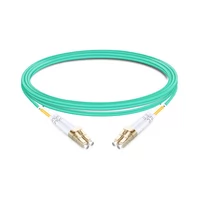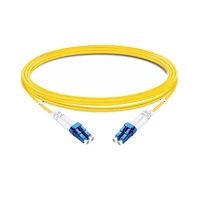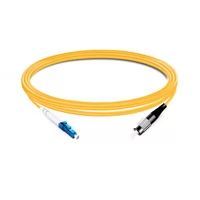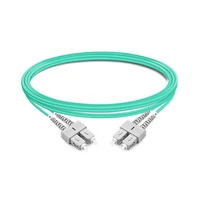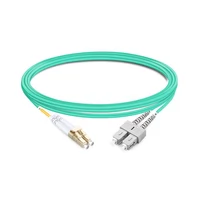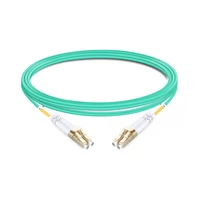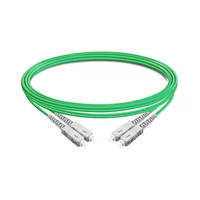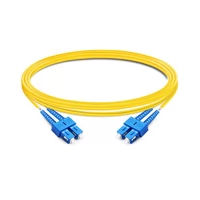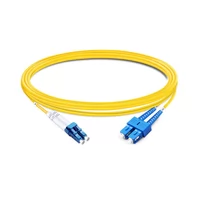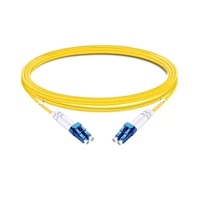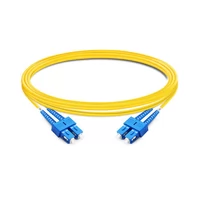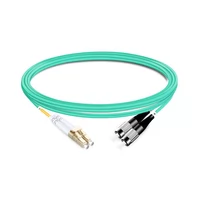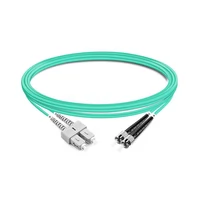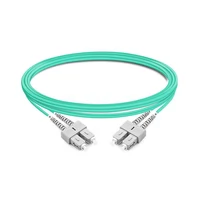Choosing the right cables for optimal performance and scalability is necessary for fiber or copper infrastructure construction and upgrading. Fiber optic and copper are the two main types of networking cables, each having properties that make them suitable for various applications. This paper compares these two options by examining their technical specifications, benefits, and drawbacks. With this information at hand, people can now choose what best meets their needs when making decisions about which cable to use in networking, whether they prioritize bandwidths, distances covered, or costs involved, among other factors listed in this article as essential considerations towards selecting suitable cable solutions during network setup or upgrade processes.
Table of Contents
ToggleWhat Are the Main Differences Between Fibre Optic and Copper Cables?

How Do Copper Cables Transmit Data?
Electric signals are used for data transmission in copper cables. They move through the metal conductors that are mainly made from pairs of twisted copper wires, where the electrical pulses are modified to show digital information. This involves translating data into an electric current that passes along the conducting copper material. Signal degradation and electromagnetic interference (EMI) might influence the quality and range of signal propagation; still, different shielding methods, as well as twisting techniques applied on these wires, help solve these issues, thereby ensuring acceptable data communication for various networking needs.
What is Fibre Optic Data Transmission?
Fiber optic data transmission is dependent on light to convey information, unlike copper cables, which use electric signals. This means that they employ laser beams or light-emitting diodes (LEDs) to create fast pulses of light, which are used in sending messages through them so, demonstrating their communication uses. The walls of these cables have to reflect the light as it moves down the pipe, or core, made from glass or plastic, usually by a process known as total internal reflection, which shows that photons travel faster than electrons. Thus, this approach enables very high bandwidths over long distances without much signal loss nor susceptibility to electromagnetic interference, thereby making fiber optics good for quick and reliable communication networks.
Comparing Bandwidth: Copper vs Fibre Optic
Fibre optics are superior to copper in terms of bandwidth. They can transmit data at much higher rates, commonly achieving terabits per second (Tbps), while copper cables are usually limited to gigabits per second (Gbps). Fiber optics’ design and material characteristics enable them to send information over longer distances without significant signal loss, which is often associated with copper wires. Hence, for high-speed and long-range communication systems with large capacity and stable connection are essential, fiber optic networks should be used instead of those based on copper technology.
How Does Bandwidth Affect Data Transmission?

Understanding Bandwidth in Copper Cables
Copper cables limit bandwidth due to physical and electrical properties. Commonly, copper cables transmit data using twisted pair or coaxial configurations where signal attenuation, crosstalk, and electromagnetic interference affect bandwidth. Typically, copper cables can only maintain up to several Gbps of maximum bandwidth depending on the category of cable used, which ranges from a few Mbps. For instance, speeds of 1 Gbps may be supported by category 5e while category 6 supports up to 10 Gbps over short distances, but this drops with distance or in high electromagnetic environments. Digital Subscriber Line (DSL) uses advanced modulation methods for increased bandwidth maximization over copper, although they still cannot match high-capacity fiber optic alternatives.
Fiber Optic Bandwidth Capabilities
Fiber optic cables provide a much higher bandwidth than traditional copper cables. With total internal reflection, light signals can be transmitted with very little loss and at incredibly high speeds. Single-mode fibers, often used in long-distance communication, can support data rates of up to 100 Gbps or more as they scale into hundreds of terabits per second when advanced multiplexing techniques are applied.
One method, called dense wavelength division multiplexing (DWDM), allows many different data streams to be sent simultaneously over various wavelengths within the same fiber, thereby greatly increasing overall bandwidth capacity. Additionally, material properties exhibited by either glass or plastic fibers contribute towards reduced attenuation and higher resistance against electromagnetic interference, enabling transmission over distances exceeding 100 kilometers without requiring signal boosters. These reasons make it obvious that fiber optics represent an ideal choice for modern telecommunications and internet infrastructure where there is a need for fast data rates alongside reliability.
Latency and Signal Loss in Copper versus Fiber
Copper wires often have high latency because of the physical characteristics of electric signals in metals. Signal corruption and delay happen due to electrical resistance and capacitance in copper cables and the speed of electrons over long distances. Signal degradation or attenuation is also greater in these types of cables. That’s why they must be amplified or repeated frequently to maintain signal strength.
Conversely, fiber optic cables rarely encounter delays since they transmit information through light pulses along glass or plastic fibers. Light travels much faster than electricity, so the latency is lower too. Materials utilized for making fiber optics have low attenuations, which reduce signal loss by a large percentage compared to other media. This permits data transmission without repeaters over longer distances, creating an efficient communication infrastructure with reliable fiber services. It is, therefore, clear that fiber vs. copper cable suit applications that need fast data transfer rates alongside minimal time lags.
What Are the Cost Implications of Using Fibre Optic Cables vs Copper?

Initial Costs: Copper Cables vs Fibre Optic Cables
Typically, the start-up costs for copper cables are lower than those of fiber optic cables, making them cheaper to implement. Copper cables are also cheaper in terms of production and installation since the technology used is well-developed and supported by existing infrastructures. The availability of tools and materials required for installation is widespread, thus reducing the upfront costs of network cable laying.
On the other hand, initial expenses associated with fiber optic cable deployments are high due to the different materials and methods used in their installation. These types of wires made from glass or special plastics are more costly compared to copper ones. Furthermore, setting up fiber optics often requires specialized equipment as well as skilled workers, thereby increasing its cost even further. However, still considering speed and reliability, among other benefits over a long-term basis, notwithstanding higher initial costs followed by low maintenance, it can be viewed as being economical, thus becoming cheap in the future.
However, every aspect relating to expenditure should be carefully considered vis-à-vis communication infrastructure needs so as to choose between either copper or fiber optics wisely.
Maintenance Costs and Lifespan of Copper and Fibre Optic
Copper wires generally need more frequent repair because they can be influenced by outside electromagnetism, rust and physical destruction. These factors may result in increased operation costs over a long time. Moreover, copper wires have a shorter life span, usually about 20-25 years.
On the other hand, compared with fiber optic cables, they are less likely to degrade in the environment and do not suffer from interference problems either, thus requiring minimum maintenance effort. Maintaining fiber optics mainly involves cleaning of connectors and sometimes upgrading equipment. Also, fiber optic cables have longer lives spanning beyond 30 years, serving as good investments for future infrastructure sustainability.
In terms of total ownership costs analysis, reduced maintenance charges together with prolonged existence expectancy of fiber optics can balance their higher initial installation prices, hence becoming more viable over time.
Which Type of Cable Should I Choose for My Network?

Use Cases: When to Choose Copper Cables
Often the cheapest option, when the budget is a primary concern for network installation, copper cables are chosen more frequently. They are also more cost-effective in short-range communication, which makes them suitable for small and medium enterprises that demand stable connections without making huge investments at first, like they would have done if they used fiber optic cables. Another advantage of using copper cable is that it works well with power over Ethernet (PoE) environments because these types can send both information alongside electrical currents, thereby eliminating the need for separate lines in the infrastructure. Copper wires may not be as fast or capable of long distances, but they offer significant bandwidths that are good enough for many typical business applications. Moreover, widespread availability and ease of put up have made them the most practical choice in most networking cases.
Advantages of Fibre Optic Cables
Fiber-optic cables have many benefits as a choice for modern network infrastructure.
- More Bandwidth: Fiber optics can support much higher bandwidths than copper cables. This enables large data centers and enterprises to meet their high-speed requirements. With this capacity, networks can handle large amounts of data without significant delays.
- Longer Reach: Unlike other types of transmission media, fiber optic cables can send signals across greater distances without weakening them. Therefore, they are suitable for long-haul communications and connecting geographically dispersed sites.
- Immune To Electromagnetic Interference (EMI): Copper wires are highly vulnerable to electromagnetic interference and radio-frequency interference, which is not the case with fiber optics. Consequently, there will be fewer data transmission errors and less signal attenuation.
- Safety: Fiber optic transmission has security advantages over other media because it is hard to penetrate a fiber optic cable without being noticed. This stronger security feature is important for organizations that deal with sensitive information.
- Strongness and Service Life: Physical damages caused by weather conditions or human activities do not affect fiber optic cables as much as they do copper ones, thus making them last longer while requiring less maintenance in the end.
Understanding these key strengths helps businesses choose the right cable type for their specific networking needs, leading to effective communication systems.
Considerations for Mixed Environments: Using Both Copper and Fibre
Many things must be considered when designing mixed environments that use copper and fiber optics to ensure seamless integration and the best performance. First, the factor of cost comes in; generally, copper cables are cheaper than fiber optic ones and may work well for shorter distances and less demanding applications. However, this higher initial investment is justified because fiber optics provide better performance over long distances or in high-bandwidth situations.
Another consideration is compatibility and interfaces. In such an environment, media converters, fiber-to-copper transceivers, or any other network hardware that can allow communication between these two types of cables might be needed. This calls for a good network architecture design so that each medium’s strengths are utilized appropriately.
Application-specific requirements should also drive where copper or fiber is deployed. For example, data centers benefit from the low latency/high-speed capabilities offered by fiber optics during server-to-server communications, while power over ethernet (PoE) enabled devices like IP cameras and access points would best work with copper cables, which deliver both electrical power and communication signals through one wire.
Lastly but not least, future-proofing and scalability have to be taken into account, too; more scalable options should be used where it’s anticipated there will be a need for increased bandwidth later on within certain parts of the network, hence making fiber optic more strategic for those areas of a network that are expected to increase or demand higher performance over time.
Therefore, organizations can carefully consider these factors to create hybrid infrastructures that take advantage of both copper and fiber optics while still ensuring reliable connectivity across their networks.
How Does Network Distance Impact Cable Choice?

Performance Over Short Distances: Copper Cables
Copper wires are the most frequently used option for short-range networks because they are cheap and easy to install. For example, copper Ethernet cables such as Cat5e, Cat6, and Cat6a can support a range of applications within the usual distance of up to 100 meters by offering enough bandwidth. Furthermore, copper has another advantage in that it can deliver Power over Ethernet (PoE) which is where both data and electricity are sent along one line, making IP cameras or wireless access points ideal devices for deployment. Nevertheless, shielding against signal attenuation and electromagnetic interference (EMI) plays an important role when dealing with these shorter distances; hence, correct installation procedures must be followed if reliability and performance are to be maintained.
Long-Distance Connectivity: Fibre Optic Cables
Fiber optic cables are the best for long-range connections as they have a lot of benefits in terms of bandwidth, signal fidelity, and future-proofing, especially when compared to copper. In contrast to copper, fiber optics use light to send data, which means there is much lower signal attenuation, enabling them to transmit information over longer distances with little loss. Fiber cables like single-mode or multi-mode can support very high speeds and are less vulnerable to electromagnetic interference (EMI), thus ensuring stable operation even in electrically noisy environments. Because of its superior performance characteristics, fiber optic is indispensable for backhaul links, data centers, and high-speed internet services. Investment into this kind of infrastructure not only caters to present networking requirements but also anticipates coming technological changes, thereby positioning itself as a strategic option for networks’ long-term scalability and reliability.
Signal Attenuation in Copper and Fibre Optic
Signal loss is important in copper and fiber optic cables as well. It happens in copper wires when the metal resists the flow of electrons and conducts poorly, which leads to a decrease in the strength of signals over long distances. This effect is even more pronounced at higher frequencies where skin depth comes into play, i.e., current flows mainly on the surface of conductors, thereby affecting electron velocity. These phenomena can also be managed through proper shielding or repeaters but are not eliminated.
On the contrary, attenuation is significantly lower in fiber optics than copper; hence, it is one of many advantages of fibers versus copper debates. Scattering and absorption within glass fibers cause most signal losses; however, this may vary depending on fiber quality during the production stage, among other factors such as materials used. The smaller core size employed by single-mode fibers and lasers as their light sources for transmission helps minimize scattering, thus reducing attenuation compared to multi-mode ones.
Although signal weakening poses challenges on both cable types, optical fibers have lower rates of signal loss over extended distances because they have better performance levels than any other wire currently available in the market.
Reference Sources
Copper conductor versus copper.
Frequently Asked Questions (FAQs)
Q: What are the main disparities between copper wiring and fiber optics?
A: Fiber optic and copper wire differ mostly in speed and susceptibility to interference. Instead of electrical signals (electron-based), optic cables send data as light (photon-based)—this means they travel at the speed of light, leading to higher transfer rates than copper wires. Also, electromagnetic interference does not affect fiber, while copper can be affected by them.
Q: Why should I use fiber for my network?
A: One should choose fiber for their network because it is faster, more reliable, and immune to electromagnetic interference. With a higher bandwidth capacity supported by optic networks, internet service delivery becomes more rapid, making them suitable for streaming services or any other high-demand application, such as online gaming, where large files must be transferred frequently.
Q: When is it better to use copper wiring instead of fiber optic?
A: Copper wires, like twisted pair coppers, may be used in short-distance, lower-cost installations that do not require high-speed data transfer. They are generally cheaper than their counterparts but good enough for most homes or small office networks.
Q: How does the cost of fiber compare with copper cable per meter lengthwise?
A: In terms of cost per unit length, fiber tends to be more expensive than its rival due to the materials and technology involved in its production. Nevertheless, this investment can pay off over time because it provides higher speeds, more excellent reliability, etc., which will protect your network against ever-increasing data demands in the future.
Q: What is the effective coverage area for fiber-optic cables?
A: As opposed to copper wires, whose maximum transmission distance without considerable signal loss is typically limited at about 100 meters when used for high-speed transmissions, thus making them only suitable within short ranges of up to 1km – 2km tops depending on specific factors.
Q: Can weather conditions affect fiber optic cables?
A: Fiber optic cables are very tough in bad weather. They don’t conduct electricity, which makes them less susceptible to lightning strikes or moisture, which can damage copper network infrastructure.
Q: Is it possible to convert a copper network into fiber optic?
A: One can upgrade an existing copper network to fiber optics. This will involve replacing the copper wires with fiber optics and may need upgrading network devices to support the same in transmission, hence the consideration of fiber versus copper. The benefits realized from such an upgrade include higher speeds, wider bandwidths, and improved signal reliability.
Q: How does data transmission work for fiber optic cables?
A: What happens is that electrical signals are converted into light by fiber optic cables through an optical fiber, which then transmits the light signals at a speed equal to that of light through the cable to enable fast and efficient transfer of data with minimum loss in signal strength and without any electromagnetic interference.
Q: Are there any situations where you must use fiber instead of copper?
A: In cases where there is a need for high-speed, long-distance data transfer, like those experienced by big businesses or enterprises, data centers, and other places with lots of EMFs around them. Additionally, modern-day highly demanding environments rely heavily on fiber optics technology to provide quality internet connectivity services, thus illustrating advantages associated with its uses over other materials such as copper.
Q: What bandwidth capabilities are offered by fiber and copper cables?
A: Copper has significantly lower bandwidth capabilities than fiber. For instance, while a 10 Gigabit per second speed can be achieved using copper over short distances, fiber optic cables can handle more data per second, thus making them suitable for applications requiring wider bandwidths.
Related Products:
-
 3m (10ft) Duplex OM4 Multimode LC UPC to LC UPC PVC (OFNR) Fiber Optic Cable
$3.90
3m (10ft) Duplex OM4 Multimode LC UPC to LC UPC PVC (OFNR) Fiber Optic Cable
$3.90
-
 3m (10ft) Duplex OS2 Single Mode LC UPC to LC UPC OFNP Fiber Optic Cable
$3.10
3m (10ft) Duplex OS2 Single Mode LC UPC to LC UPC OFNP Fiber Optic Cable
$3.10
-
 3m (10ft) Simplex OS2 Single Mode LC UPC to FC UPC PVC (OFNR) Fiber Optic Cable
$1.40
3m (10ft) Simplex OS2 Single Mode LC UPC to FC UPC PVC (OFNR) Fiber Optic Cable
$1.40
-
 1m (3ft) Duplex OM3 Multimode SC UPC to SC UPC OFNP Fiber Optic Cable
$3.00
1m (3ft) Duplex OM3 Multimode SC UPC to SC UPC OFNP Fiber Optic Cable
$3.00
-
 1m (3ft) Duplex OM3 Multimode LC UPC to SC UPC OFNP Fiber Optic Cable
$3.00
1m (3ft) Duplex OM3 Multimode LC UPC to SC UPC OFNP Fiber Optic Cable
$3.00
-
 1m (3ft) Duplex OM3 Multimode LC UPC to LC UPC OFNP Fiber Optic Cable
$3.00
1m (3ft) Duplex OM3 Multimode LC UPC to LC UPC OFNP Fiber Optic Cable
$3.00
-
 1m (3ft) Duplex OM5 Multimode SC UPC to SC UPC LSZH Fiber Optic Cable
$3.40
1m (3ft) Duplex OM5 Multimode SC UPC to SC UPC LSZH Fiber Optic Cable
$3.40
-
 1m (3ft) Duplex OS2 Single Mode SC UPC to SC UPC OFNP Fiber Optic Cable
$2.50
1m (3ft) Duplex OS2 Single Mode SC UPC to SC UPC OFNP Fiber Optic Cable
$2.50
-
 1m (3ft) Duplex OS2 Single Mode LC UPC to SC UPC OFNP Fiber Optic Cable
$2.50
1m (3ft) Duplex OS2 Single Mode LC UPC to SC UPC OFNP Fiber Optic Cable
$2.50
-
 1m (3ft) Duplex OS2 Single Mode LC UPC to LC UPC OFNP Fiber Optic Cable
$2.50
1m (3ft) Duplex OS2 Single Mode LC UPC to LC UPC OFNP Fiber Optic Cable
$2.50
-
 1m (3ft) Duplex OS2 Single Mode SC UPC to SC UPC LSZH Fiber Optic Cable
$2.70
1m (3ft) Duplex OS2 Single Mode SC UPC to SC UPC LSZH Fiber Optic Cable
$2.70
-
 1m (3ft) Duplex OM4 Multimode LC UPC to FC UPC PVC (OFNR) Fiber Optic Cable
$2.90
1m (3ft) Duplex OM4 Multimode LC UPC to FC UPC PVC (OFNR) Fiber Optic Cable
$2.90
-
 1m (3ft) Duplex OM4 Multimode SC UPC to ST UPC PVC (OFNR) Fiber Optic Cable
$3.00
1m (3ft) Duplex OM4 Multimode SC UPC to ST UPC PVC (OFNR) Fiber Optic Cable
$3.00
-
 1m (3ft) Duplex OM4 Multimode SC UPC to SC UPC PVC (OFNR) Fiber Optic Cable
$3.00
1m (3ft) Duplex OM4 Multimode SC UPC to SC UPC PVC (OFNR) Fiber Optic Cable
$3.00

